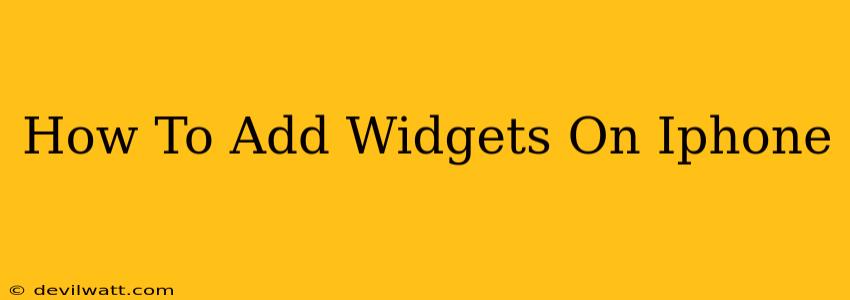Adding widgets to your iPhone's home screen is a simple yet powerful way to personalize your device and access information at a glance. Widgets provide quick access to your favorite apps and features, displaying important updates without needing to open the app itself. This guide will walk you through the process step-by-step, covering everything from finding the right widgets to customizing your home screen layout.
Understanding iPhone Widgets
Before diving into the how-to, let's clarify what widgets are and why you might want to use them. iPhone widgets are mini-applications that display key information from their parent apps directly on your home screen. Think of them as interactive snippets of your favorite apps – displaying things like upcoming calendar events, weather updates, news headlines, or even your fitness progress.
Benefits of Using iPhone Widgets:
- Increased efficiency: Quickly access information without opening apps.
- Personalized home screen: Customize your home screen with relevant information.
- Improved organization: Consolidate important information in one easily accessible place.
- Enhanced visual appeal: Add a visually appealing layer to your home screen.
How to Add Widgets to Your iPhone Home Screen
Adding widgets is incredibly straightforward. Here's a step-by-step guide:
Step 1: Enter Jiggle Mode
To begin, you need to enter "jiggle mode" on your iPhone. This allows you to rearrange apps and add widgets. You do this by performing a long press (hold your finger down) on an empty space on your home screen. After a moment, the icons will start to wiggle, and a small "x" will appear in the corner of each app icon. This indicates you're in edit mode.
Step 2: Access the Widget Menu
Now, tap the "+" button located in the upper left corner of the screen. This will open the "Widget Gallery," which displays all the widgets available on your iPhone.
Step 3: Choosing and Adding Your Widgets
The Widget Gallery is organized into categories, making it easy to find widgets from different apps. Browse through the available widgets and tap the "+" button next to the one you want to add. You can adjust the size of the widget by selecting the option from the available widget sizes offered.
Step 4: Arranging Widgets on Your Home Screen
Once you've added a widget, you can drag and drop it to the desired location on your home screen, just like you would rearrange apps. You can also create multiple pages of widgets if needed to organize them effectively.
Step 5: Exit Jiggle Mode
Once you're satisfied with the placement of your widgets, simply tap the "Done" button in the upper right corner of the screen. This will exit jiggle mode, and your widgets will be permanently placed on your home screen.
Tips for Maximizing Widget Usage:
- Experiment with different widget sizes: Find the best size for each widget to maximize information display and screen real estate.
- Organize your widgets logically: Group similar widgets together (e.g., news widgets, productivity widgets) for easier access.
- Regularly review your widgets: Remove or replace widgets that are no longer relevant or useful.
- Check for updates: App updates often introduce new widgets or features for existing ones.
Adding Widgets from the App Library
If you can't find a specific app's widget on your home screen, you might need to locate it in your App Library. This centralized location for all your apps is a great place to check if the app supports widgets. Locate the app, tap and hold on the app icon, and then select the "Add Widget" option if available.
By following these simple steps, you can transform your iPhone home screen into a highly personalized and efficient workspace. Experiment with different widgets and layouts to find the perfect combination for your needs and preferences! Now go forth and widget!

